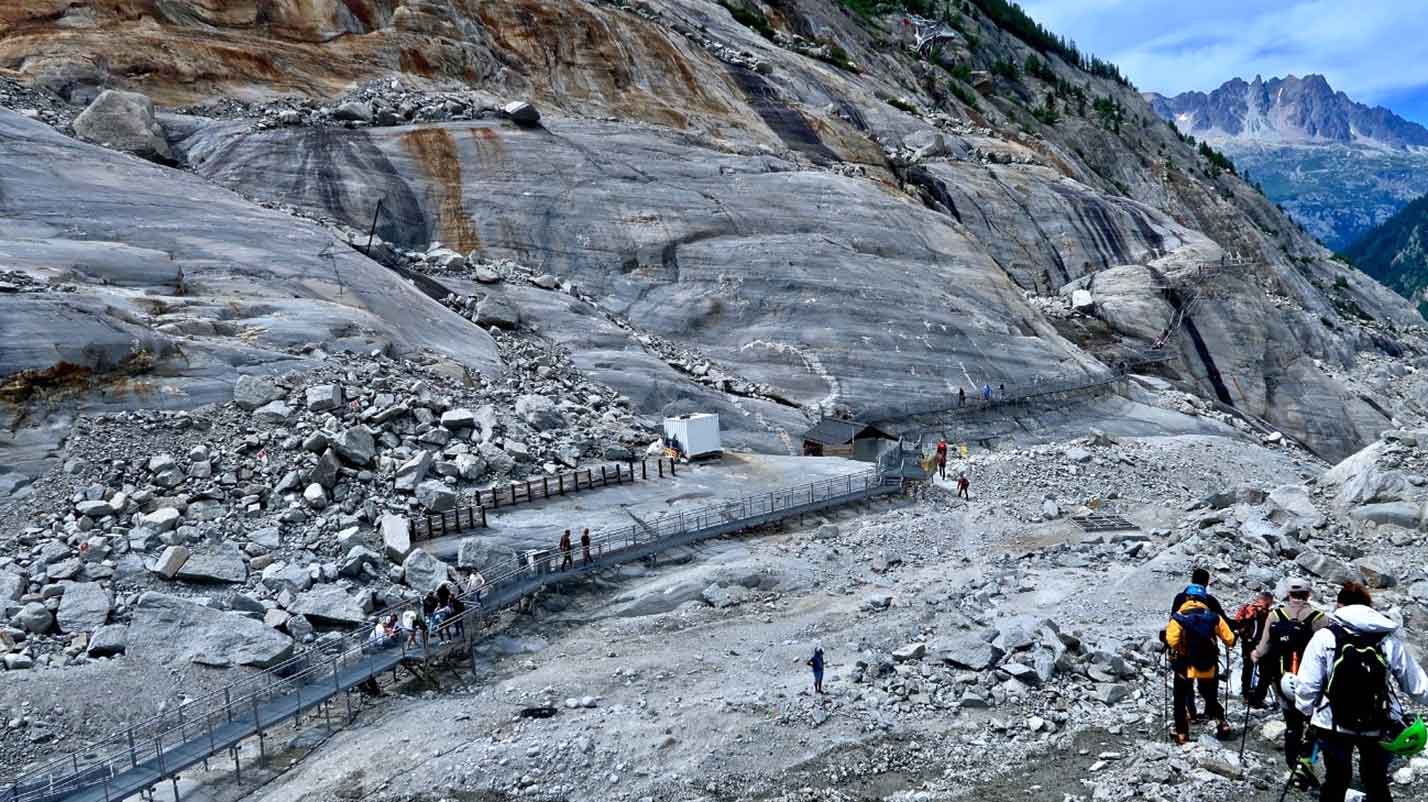
Mer de Glace, with Mont Blanc summit in the background. The supraglacial debris now completely covers the last two kilometers (Photo: J.-F. Hagenmuller).
Geological Period
Quaternary
Main geological interest
History of geosciences
Geomorphology and active geological processes
Location
Mont-Blanc massif (Western European Alps)/ Auvergne-Rhône-Alpes Region, France
45°54’03”N, 006°56’45”E
Mer de Glace, with Mont Blanc summit in the background. The supraglacial debris now completely covers the last two kilometers (Photo: J.-F. Hagenmuller).
One of the most emblematic glaciers of the world, studied as early as the 18th century
The Mer de Glace has been one of the first studied glacier in the world, as early as the 18th Century by de Saussure. Scientific activity has been growing from the 19th century, and Mer de Glace has become nowadays a key place both for the reconstruction of glacier fluctuations during the Holocene (Le Roy et al., 2015) and the LIA (Nussbaumer and Zumbhül, 2007) and for the assessment of its future dynamics under the current climate change (Vincent et al., 2019; Peyaud et al., 2020). The site is easily accessible to half a million visitors per year since 1909.
- Geological description
The Mer de Glace is the third largest glaciers in the European Alps. It had an area of 28 km2 in 2022 including Glacier de Leschaux, its main tributary. It flows from 4205 m asl along 11.5 km, down to 1547 m asl in 2021. Ice thickness ranges from c.300 m where the Tacul and Leschaux Glaciers meet to c.30 m below the Montenvers, Surface ice velocity decreases from 75 to 20 m yr-1, respectively – the ice velocity is maximal (500 m yr-1) at the steep Géant icefall. The Mer de Glace is surrounded by high steep granitic rockwalls culminating at the Aiguille du Midi (3842 m asl), Aiguille Verte (4122 m), and Grandes Jorasses (4208 m). Rockfalls that detached from these permafrost-affected rockwalls, glacially eroded material, and paraglacial reworking of till material from the large lateral moraines have actively supplied debris to the glacier surface since the end of the Little Ice Age (LIA; Deline, 2005). The Mer de Glace front reached the Chamonix valley floor during the second half of the LIA; it then retreated by 2.7 km since 1852 CE, a retreat shortly interrupted by three readvances culminating in 1896, 1931 and 1995.
- Scientific research and tradition
Since the 18th century, the Mer de Glace is studied by many scientists, who published a huge literature. A dedicated museum (enlarged for 2026) and scientific and educational projects have been implemented to promote knowledge of glaciers by a wide audience, in particular as a witness to climate change.
- Reference
Deline, P. (2005) ‘Change in surface debris cover on Mont Blanc massif glaciers after the“Little Ice Age” termination’, The Holocene, 15(2), pp. 302–309. Available at: https://doi.org/10.1191/0959683605hl809rr.
Le Roy, M. et al. (2015) ‘Calendar-dated glacier variations in the western European Alps during the Neoglacial: the Mer de Glace record, Mont Blanc massif’, Quaternary Science Reviews, 108, pp. 1–22. Available at: https://doi.org/10.1016/j.quascirev.2014.10.033.
Nussbaumer, S., Zumbühl, H. and Steiner, D. (2007) ‘Fluctuations of the Mer de Glace (Mont Blanc area, France) AD 1500-2050: an interdisciplinary approach using new historical data and neural network simulations’, Zeitschrift für Gletscherkunde und Glazialgeologie, 40, pp. 1–183.
Nussbaumer, S.U. et al. (2012) Mer de Glace. Art et science, Mer de Glace. Art et science. Edited by: Nussbaumer, Samuel U; Deline, Philip; Vincent, Christian; Zumbühl, Heinz J (2012). Chamonix: Atelier Esope. Chamonix: Atelier Esope. Available at: https://www.zora.uzh.ch/id/eprint/85505/.
Peyaud, V. et al. (2020) ‘Numerical modeling of the dynamics of the Mer de Glace glacier, French Alps: comparison with past observations and forecasting of near-future evolution’, The Cryosphere, 14(11), pp. 3979–3994. Available at: https://doi.org/10.5194/tc-14-3979-2020.
Vincent, C. et al. (2019) ‘Déclin des deux plus grands glaciers des Alpes françaises au cours du XXI e siècle : Argentière et Mer de Glace’, La Météorologie, (106), pp. 49–58. Available at: https://doi.org/10.4267/2042/70369.
- Author(s)
Philip Deline.
Laboratoire EDYTEM, Université Savoie Mont Blanc – CNRS, Chambéry, France.
Ludovic Ravanel.
Laboratoire EDYTEM, Université Savoie Mont Blanc – CNRS, Chambéry, France.


